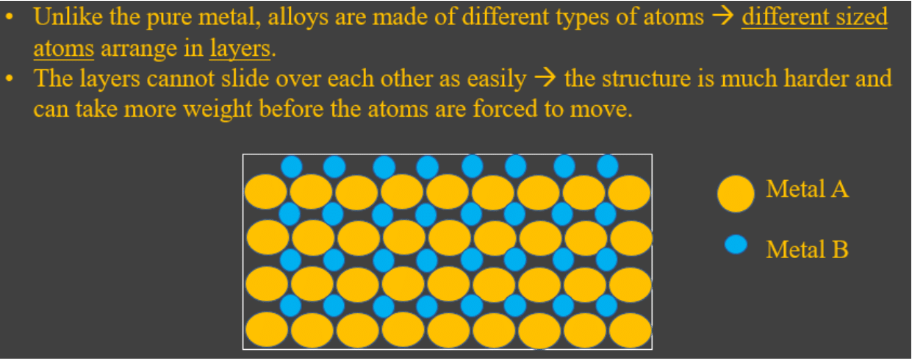In this lesson, we will learn:
- The definition of an alloy and how alloys and metals are related.
- To explain the benefits of using metal alloys over pure metal substances.
- To explain how the structure of an alloy gives it unique properties to its constituent metals.
Notes:
- As seen in Metallic bonding, the properties we see in pure metals are explained by the features of metallic bonding and the structure that it creates.
- Remember what scientists are doing here. We study metals and find their properties such as high melting point, they are malleable etc. THEN we create the theory of metallic bonding that explains these properties and predicts others that we can test.
- Strength, which is the ability to withstand a force without breaking;
- Hardness, which is the resistance to being deformed (having its shape broken).
- Alloys are mixtures of two or more metals (or carbon) combined to enhance properties.
- Alloys still have the metallic (non-directional) bonding and structure of pure metals but are harder than the individual pure metals they are made of.
- By adding a second element into the metal structure, there is a major effect on the metal ions ability to move past each other. Unlike the pure metal, the alloy is made of different types of atoms and therefore different sized atoms arrange in layers. The layers of atoms cannot slide over each other as easily, so the structure is much harder and can take a larger weight load before the layers of ions are forced to move.
See the diagram below: - There are many examples of alloys used in our everyday lives. Some examples include:
- Steel which is an alloy of iron and carbon. Used in buildings and many other structures, there are a lot of different steel alloys depending on the ratio of iron to carbon.
- Amalgam which is an alloy of mercury, silver and other metals used in dental fillings.
- Brass which is an alloy of copper and zinc used in locks, gears, and valves. Brass is resistant to rust and corrosion, so moving parts made of brass will not damage as quickly due to moisture or wear and tear. Brass is also used in musical instruments.
- Smart alloys are alloys which are able to return to their original shape after being bent, by heating or electrifying it. This is a useful property for making glasses frames and other items that need to be a little bit flexible.
A lot of every day uses of metals rely on these properties:
However, many of these metals we use in real life situations are not pure metals because pure metals have relatively low strength and hardness.
Remember metallic bonding: in pure metals, the ions arent stuck in place, so if you apply pressure (like putting a lot of weight on it) pure metals dont hold up very well. Under very heavy weight loads they will change shape and fail structurally over time. In practice, this means that pure metals are not very useful in the most physically demanding of structures, such as in buildings or bridges.

In the end, the property changes enhance metal properties. We use metals for a variety of properties; alloying them makes them even better suited for their specific uses.






